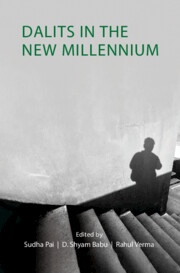Book contents
- Frontmatter
- Contents
- List of Figures
- List of Tables
- Acknowledgements
- 1 Introduction: Dalit Discourse in the New Millennium
- Part I Shifting Patterns of Electoral Politics
- 2 Voting Patterns among Dalits since the 1990s
- 3 On the Peculiar Absence of Dalit Politics: Punjab and West Bengal
- 4 Decline of the Bahujan Samaj Party: Dalit Politics under Right-Wing Hegemony
- 5 A Democratic Dilemma: Dalit Parties, Campaign Finance, and Coalition Politics
- 6 Why Are More Dalits Voting for the Bharatiya Janata Party since 2014?
- Part II Popular Culture, Discourse, and Protest
- Part III Transformations in Ideology and Identity
- Part IV Aspirations and Anxieties
- Part V Discrimination and Representation
- About the Contributors
- Index
3 - On the Peculiar Absence of Dalit Politics: Punjab and West Bengal
from Part I - Shifting Patterns of Electoral Politics
Published online by Cambridge University Press: 12 July 2023
- Frontmatter
- Contents
- List of Figures
- List of Tables
- Acknowledgements
- 1 Introduction: Dalit Discourse in the New Millennium
- Part I Shifting Patterns of Electoral Politics
- 2 Voting Patterns among Dalits since the 1990s
- 3 On the Peculiar Absence of Dalit Politics: Punjab and West Bengal
- 4 Decline of the Bahujan Samaj Party: Dalit Politics under Right-Wing Hegemony
- 5 A Democratic Dilemma: Dalit Parties, Campaign Finance, and Coalition Politics
- 6 Why Are More Dalits Voting for the Bharatiya Janata Party since 2014?
- Part II Popular Culture, Discourse, and Protest
- Part III Transformations in Ideology and Identity
- Part IV Aspirations and Anxieties
- Part V Discrimination and Representation
- About the Contributors
- Index
Summary
Despite being home to some of the largest proportions of Dalit population across states in India, neither Punjab nor West Bengal has given rise to the robust presence of radical Dalit political assertion, particularly of the Ambedkarite variety, in the formal institutions of the government. What explains this puzzling absence? Indeed, this is a question that has been raised with respect to both states, even if in their distinct regional contexts. While demographics alone may not be the surest indicator of political dynamics, the sheer size of the Dalit population in both regions invites closer inspection. As per the data available from the 2001 census of India, Punjab's Dalits accounted for 28.9 per cent of its total population, or just over seven million people. The comparable figure for West Bengal was 23 per cent, or nearly 18.5 million people. Uttar Pradesh (UP), arguably the most important site for the articulation of radical Dalit political assertion, lagged behind both states at just over 21 per cent, even if the actual number of individuals concerned was substantially higher (Census of India, 2011).
The high proportion of Dalits in the respective populations of the two states is not the only factor that invites comparison between them. Another obvious source of comparison would be the fact that both states were carved out of the only two provinces that were divided during the partition of British India. Furthermore, and of course related to this historical predicament, was the presence of a degree of religious heterogeneity observable in a relatively few other provinces of late-colonial India. In addition, both regions are situated at the geographical margins, historically speaking, of what is commonly supposed to be the heartland of Brahminical supremacy. Both, for a variety of complex reasons, have been subject to the mythology that ‘caste does not matter’. There are thus a number of reasons to undertake comparison between these two otherwise distinctive states with specific regard to Dalit political assertion or its relative failures.
This chapter surveys some of the available literature that speaks, directly or indirectly, to the question framing this comparative investigation from the partition of India onwards.
- Type
- Chapter
- Information
- Dalits in the New Millennium , pp. 45 - 58Publisher: Cambridge University PressPrint publication year: 2023

